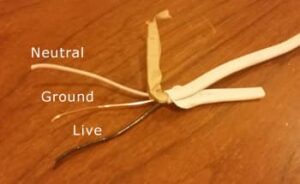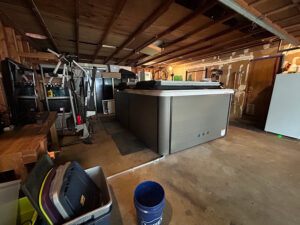Time to chat about the types of electrical wiring in homes — or rather, the types of electrical wiring in most homes.
With the advent of “smart” appliances, massive entertainment systems that require the internet, and other technological advances, residential homes have a wide range of wiring hidden behind the walls.
Still, for homes built in the last 60 years or so, the bulk of the types of wiring in most homes has remained consistent: one live/hot wire, one neutral wire, and one ground/earth wire.
Circuits
In order for the house to have power, several electrical circuits need to be completed. If you know where your electrical panel is, take a look at how many circuit breakers there are. Each breaker represents a part of your home that is receiving power, such as a master bedroom, family room, kitchen, and anywhere else that is receiving electricity.
Essentially, a circuit is a loop that starts by sending electricity out to all of the outlets, light switches, and other fixtures for a given room. However, to complete the circuit, the flow of power needs to be brought back to the breaker. If the flow is interrupted, the entire circuit is shut down.
The live wire sends the power out and the neutral wire brings it back.
The ground wire is in place as a safety measure; it is meant to absorb any surges along the line.
Sheathing and Materials
In most cases, the live wire is covered in black sheathing, the neutral wire in white sheathing, and the ground wire is left bare or has a green sheathing.
Individual wires are made of the same material, but the different colors help to differentiate between the three down the line. Imagine trying to keep the wires straight through a junction box, four or five outlets, and a light fixture/switch without color coding to assist you along the way!
All three wires are encased in another sheathing (often metallic sheathing) that acts as protection and keeps the wires together. That’s important because the wire is run throughout the home, along joists, through wall studs, and in and out of junction boxes.
If you’ve ever seen a remodel or new build taking place, you’ll see just how much electrical cable and wiring are involved to ensure you can microwave popcorn on movie night.
Breakers and Gauges
While you could run one circuit throughout the entire house, that would be entirely too much load for one breaker. That’s why there are so many breakers in the panel, each designed for a particular part of the house.
A dedicated dryer line, for example, will use a 30 Amp breaker, while a circuit to the den may use 20.
Wires also come in different sizes (gauges; for example, 14-gauge wire). It’s important that the appropriate wires are used in the correct breakers. If not, the breaker will continually shut off or may even cause damage to the panel itself. In most cases, however, the wires throughout the house are the same gauge.
Codes and Safety Standards
As we said earlier, however, while residential electrical wiring does have some differentiation — the dryer example comes to mind — the bulk is made up of one black, one white, and one bare (or green) wire. All three work together to keep the lights on and protect the system if there is an issue along the line at any point.
Your home’s electrical system, wires and cables, underground feeder cables (UF cables), and other common types of electrical wiring in homes most likely conform to an industry standard known as the National Electrical Code (NEC). This is not a federal code or law but rather a way to standardize the enforcement of electrical work.
The code also provides standards for which a home’s electrical wiring is labeled as appropriate for dry, damp, or wet locations and other types of electrical installations.
The NEC is essentially a set of safety guidelines that govern the installation and maintenance of electrical wiring in residential (and commercial) structures. First developed in 1897 as a way to standardize electrical wiring practices across all states, it has grown into a comprehensive set of standards designed to protect people from electrical hazards.
The NEC covers topics such as wiring materials, grounding systems, circuit breakers, outlets, lighting fixtures, and more. It also requires certain types of labels on wires and cables so that they can be easily identified by homeowners or electricians when necessary.
More on Safety
Knowing about the NEC is important for homeowners interested in the different types of electrical wiring in homes because it serves as a blueprint for how electrical wiring should be installed in order to be safe. It ensures that all homes are wired with proper safety measures in place so that any potential problems can be quickly identified and corrected before they become serious issues. Additionally, understanding the NEC will help you recognize any potential hazards or areas where repairs may be needed in your home’s electrical system.
As always, we recommend — highly recommend — having a professional electrician review any problems or areas of concern you may be experiencing with your home’s electrical system.
Understanding — or at least being able to recognize — the different types of electrical wiring in the home — is a good idea for homeowners, landlords, and other property owners.
We think everyone should at least familiarize themselves with these principles so they can recognize any potential problems or areas where repairs may be needed in their home’s wiring system.
By reviewing this information, homeowners may be able to reduce any potential risks or threats to their home’s electrical system. It’s especially important for DIY home improvement projects, from small tasks, such as changing light bulbs, to larger ones, such as installing new appliances.
Consult a certified electrician at Prairie Electric if you are unsure about any specific aspects of your home’s electrical system — or for any other electrical-related questions or concerns.
This post was updated on 12/20/22.


